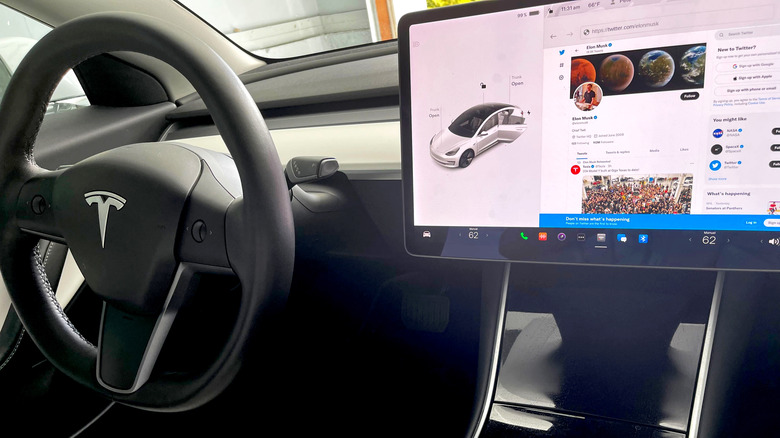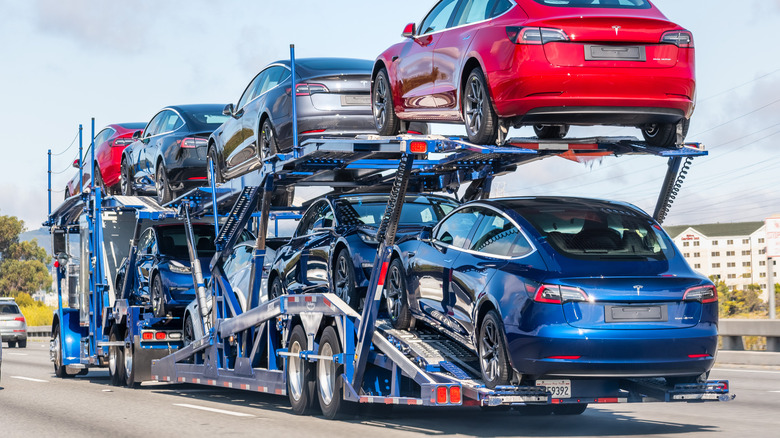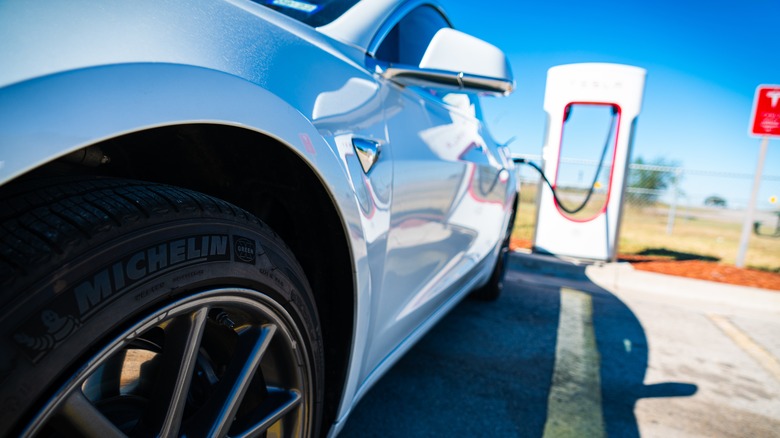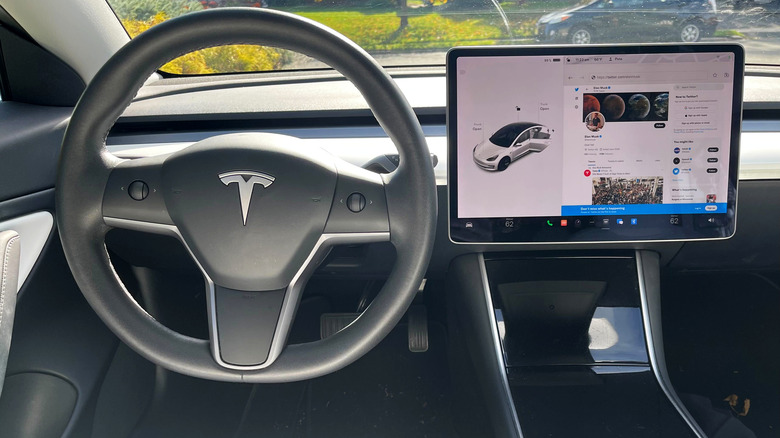How Twitter Could Help Tesla Owners Pioneer The Future Of Electric Vehicles
Elon Musk's changes to Twitter may still be a work-in-progress, not to mention plenty controversial, but the social network's potential beyond sharing memes may well end up more lucrative. After all, the billionaire has been as outspoken about vertical integration in the past as he has been about free speech in recent months, and if there's one thing Tesla has no shortage of, it's vocal enthusiasts.
It's not as well-publicized as some of Elon Musk's projects, but Tesla does already have a social media platform of sorts. Engage Tesla launched in early 2021, as "a digital home base" for the automaker and its fans that would "make it easier for Tesla community members to learn what's top of mind for us, take meaningful action, and stay in the loop."
Since then, the focus has been primarily on how Tesla owners and enthusiasts can weigh in on public policies that affect electric vehicles, solar power, and other topics relevant to Elon Musk's growing empire. That has included highlighting ways to give public comment on California's proposed solar panel tax, as well as encouraging New York to allow direct sales of vehicles and bypass the traditional dealer model.
In short, it's an attempt to harness the collective motivation of Tesla fans — something seldom in short supply — to help promote things that Tesla and its businesses could benefit from. Engage Tesla also has (or rather, had) a section encouraging EV drivers to sign up for their nearest Tesla Owners Club, with an embedded Google Calendar of upcoming events.
Tesla owners are used to proving themselves to Musk
All the same, it's clear that Tesla Engage in its current form is more of a one-way process. Tesla also retired its official forum in 2021, ceding that space to third-party communities. Certainly — as Elon Musk is currently discovering — things like content moderation at scale are difficult, particularly when you're trying to turn a profit from tools like verification.
Ironically, though rumors of a hefty monthly fee for a coveted Twitter blue check may send some scurrying from the platform, Tesla owners are already content paying tens of thousands of dollars for their electric cars. Tying identity verification into vehicles themselves would be one relatively straightforward shortcut to making sure people truly are who they claim to be, at least on the backend.
We've already seen moves by Tesla to do something along those lines, albeit with a very different focus. Access to the Full Self-Driving Beta requires owners of Musk's cars to achieve and maintain a certain "safety score" beforehand, demonstrating that they're sufficiently attentive and considerate behind the wheel. Without that, drivers can be blocked from the beta program — even if they've paid the not-inconsiderable fee for the related hardware on their EV — or ejected from it.
Twitter has flirted with secret groups already
Twitter, meanwhile, has also experimented with private channels. While so-called "alt" accounts — typically locked so that only a known audience can view them and interact — are commonplace, Twitter Circles rolled out to all users earlier this year as an official way to create a subgroup within an otherwise more public account. Users can select who is in their circle, share only with those people, and only those within the circle can see any responses.
Currently, Twitter Circles are limited to 150 accounts. However, it's not hard to imagine a system whereby Twitter was the structure within which different groups could be operating; in fact, Musk has already seemed amenable to such a strategy. One such group could be of other Tesla owners, organized by location or common interests, and relying on the Twitter backend for not only socializing but sharing useful EV data.
For example, one common issue facing all electric vehicle drivers is public charger outages. Tesla's Supercharger network has alleviated some of that stress, but it can still be difficult to find close-to-real-time information on which chargers are operational, which are working but perhaps slower than billed, or other problems. A Twitter-powered, localized social group could be used to share such updates, either actively by the driver or even automatically by the car itself.
That's something Twitter-using Tesla owners can actually do, in part at least, currently. Though there's no Twitter app for Tesla's infotainment system, the Chromium-based web browser can be used to log into a Twitter account. At the moment, though, there are no special features beyond what anybody using the web interface can access.
The code is there, ripe for the tweaking
According to insiders, Elon Musk has already had Tesla's software engineers taking a look through Twitter's source code. Just what they're looking for at this stage is unclear and — though Musk seems to be going full steam ahead with early changes — it's worth remembering that he's only been the social network's owner for less than a week. Nonetheless, Tesla has a reputation for aggressive feature updates, as owners of its EVs are well aware.
It also aims to make ownership of those cars sticky, and Musk has been a vocal advocate in the past of vertical integration. After all, that's why he was so enthusiastic about bringing SolarCity into the Tesla fold. Generating, storing, and then supplying green electricity to homes and vehicles makes a lot of sense, not to mention potentially assisting with economies of scale.
With Musk's $44 billion outlay on Twitter considerable, and his investors expecting rapid returns, squeezing out maximum profit from the site is an obvious priority. Utilizing it as the backend for Tesla drivers — and their cars and, one day, maybe even their homes — to communicate might be one way to do that. After all, Twitter owners may be revolting at the idea of a subscription for verification, but plenty of Tesla buyers have been happy to spend thousands on hardware based on the promise that it may, one day, allow their EVs to drive themselves.



